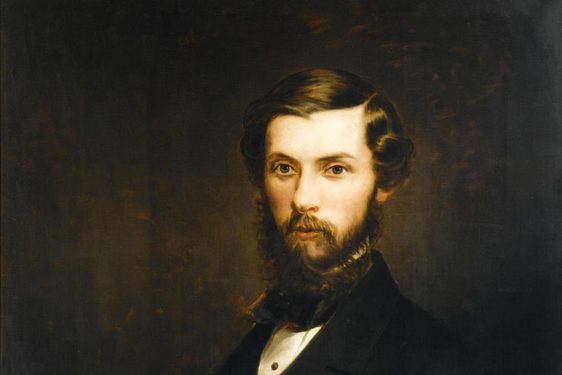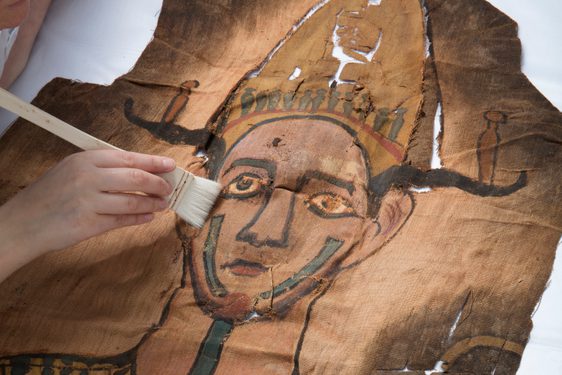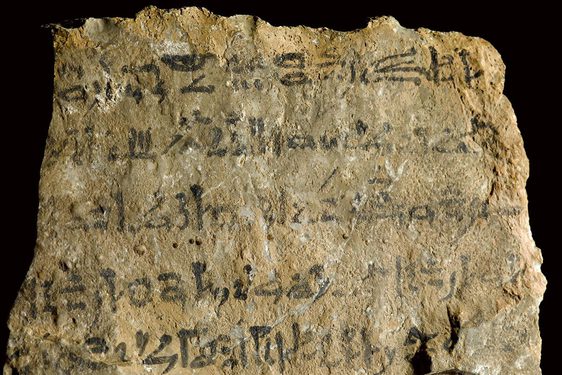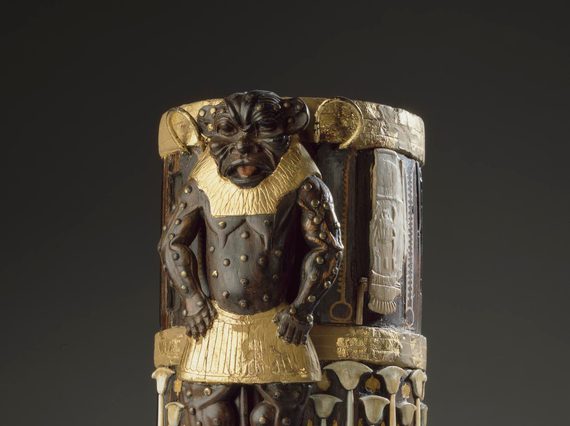
An ancient Egyptian masterpiece: The box of King Amenhotep II
News Story
A box inscribed with the name of King Amenhotep II is one of the finest examples of decorative woodwork to survive from ancient Egypt. Discover the rich symbolism of the box and how fragments found later helped our understanding of this unique object.
A box fit for a king
This cylindrical box was made in honour of the King Amenhotep II who ruled ancient Egypt during the 18th Dynasty (around 1427–1400 BC). He succeeded to the throne after his father Thutmose III (1479–1425 BC). Egypt’s empire probably reached its greatest extent, stretching from modern Syria to Sudan, under Thutmose III.
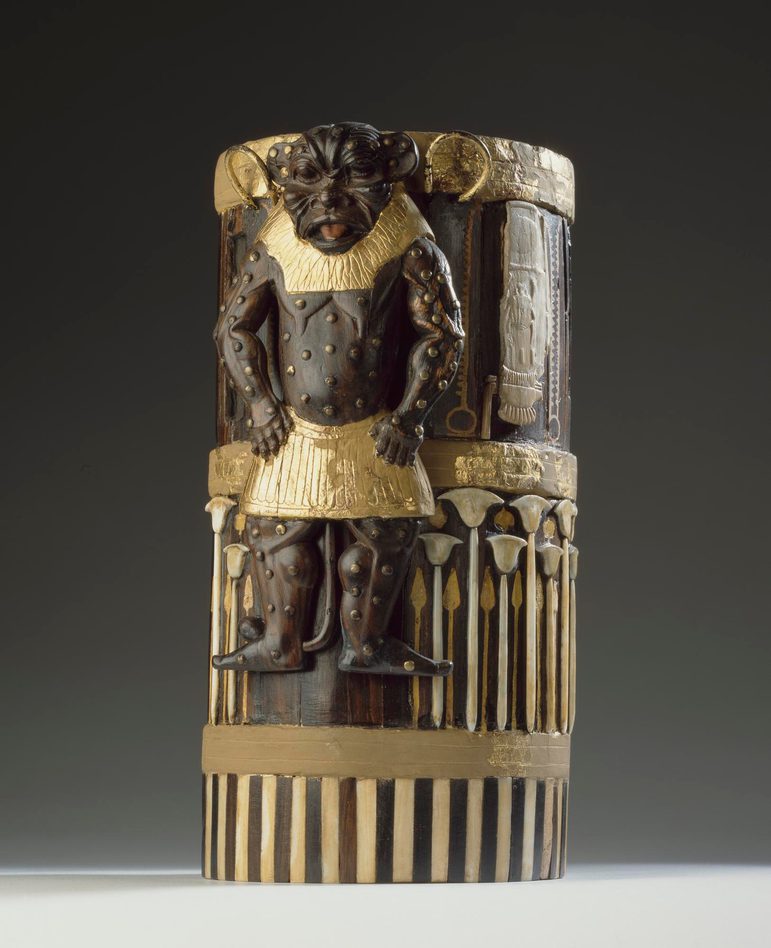
Decorative Box of Pharaoh Amenhotep II. Museum reference A.1956.113.
The box is richly decorated with exotic materials from different areas of the ancient Mediterranean. This signifies the extent of the king’s empire and its wealth. The main body is made of cedar wood, which was imported from Lebanon and valued for its quality, as suitable sources of wood were not abundant in Egypt. The gold may have been mined in Egypt’s Eastern Desert or in Nubia (ancient Sudan).
The box is overlaid with ivory plaques, made from either hippo or elephant tusk. Elephants were not native to Egypt and ivory was imported or given as tribute from further south in Africa. The veneers of ebony, a highly-prized dark hardwood, probably came from the land of Punt with whom the Egyptians traded. Our name for this wood, ‘ebony’ actually comes from the ancient Egyptian name for it, ‘hebeny’.
The box is a much more elaborate version of the types of wooden containers often found in ancient Egyptian tombs. It most likely belonged to a granddaughter or great-grandaughter of Amenhotep II, and was probably used to hold cosmetics or expensive perfumes. The closest parallels to such an elaborate wooden box as this are those found in the tomb of Tutankhamun (around 1336–1327 BC), and in the tomb of his grandparents Yuya and Tjuyu.
Who was Amenhotep II?
Amenhotep II was not originally the intended heir to the throne. He only became crown prince after his elder brother died, and he came to the throne at age 18. While still a prince, he served as a military commander. He was renowned for his athletic prowess, much like his father, but it is likely that this was exaggerated as a form of royal propaganda. It was said that he once shot four arrows through four copper targets, each one palm thick, while riding on horseback.
The stela (large inscribed stone slab) of Amenhotep II at Giza tells of his strength and endurance:
Strong of arms, untiring when he took the oar, he rowed at the stern of his falcon-boat as the stroke-oar for two hundred men. Pausing after they had rowed half a mile, they were weak, limp in body, and breathless, while his majesty was strong under his oar of 10.5 metres in length. He stopped and landed his falcon-boat only after he had done three miles of rowing without interrupting his stroke. Faces shone as they saw him do this.
Amenhotep II led numerous military campaigns over the course of his reign, but later in his reign he seems to have achieved peace with Egypt’s neighbours.
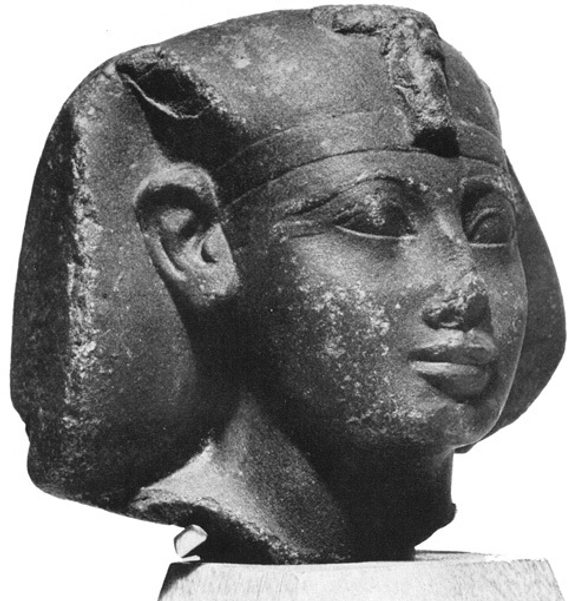
Head of an 18th Dynasty king thought to be Amenhotep II. Museum reference A.1951.346.
Bes, the protective household god
The main figure depicted on the decorative box of Amenhotep II is a protective god and household guardian known as Bes. A number of similar deities are known from ancient Egypt, but in the absence of an inscription identifying the figure specifically, he is usually referred to as Bes.
Bes is depicted as a dwarf with lion-like features and sometimes wears a Nubian-style headdress with feathers. In ancient Egypt, people with dwarfisms were thought to be emblematic of good fortune and many such individuals worked as entertainers. They were also considered to be very skillful, working as expert craftsmen, or even as important state officials to the king.
As a joyful symbol of good luck, Bes is sometimes shown dancing and playing the tambourine. His protective role is evident from his fearsome appearance, which was intended to scare off potential dangers and evil spirits. He is often depicted brandishing knives and sticking out his tongue. He is somewhat comparable to modern European gargoyles whose presence on churches was intended to ward off evil. Bes’ popularity spread throughout the ancient Mediterranean. Depictions of him have been found in Cyprus, Assyria, and elsewhere.
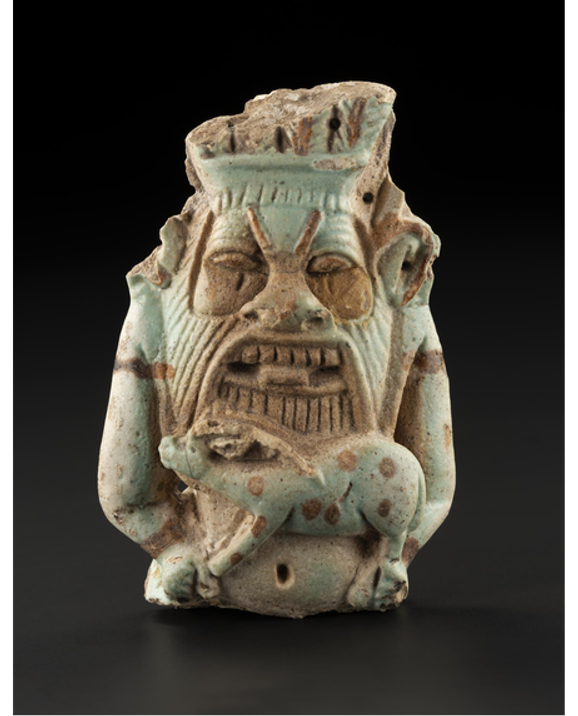
Pale green faience amulet of the god Bes holding an oryx. Ancient Egyptian, probably Roman Period, c. 30 BC - AD 395. Museum reference A.1965.338.
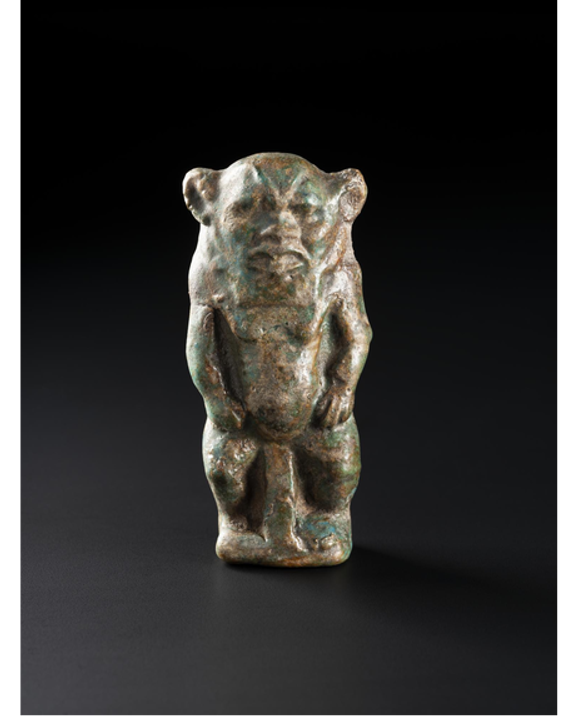
Green faience figurine of the god Bes. Ancient Egyptian, New Kingdom, 18th Dynasty, c.1550-1295 BC. Museum reference A.1956.86.
As a household guardian and protector of the family, Bes frequently appears as a decorative and protective element on amulets. He is also found on household items such as headrests and furniture. Another wooden figure of Bes in the National Museums Scotland collection probably comes from a piece of furniture, possibly from the back of a chair.
Although he is generally thought of as a domestic god, worshipped in the home, as opposed to one of the state gods, such as the sun god Ra, who was worshipped in huge temples built by the pharaohs, Bes was obviously still considered worthy enough to feature on a household item in the royal palace.
Symbolism in the box's design
The box of Amenhotep II features a number of other decorative elements in addition to the main figure of the god Bes. The oval-shaped ivory plaques depict a name of Amenhotep II within a cartouche; an oval used to encircle royal names which symbolised eternity. Ancient Egyptian names generally took the form of phrases that described their owner in positive terms, often in relation to a god or goddess.
An Egyptian king generally had five names: his birth name, plus four new names. The new names were adopted at his coronation in order to emphasise his divine right to rule and convey a kind of mission statement for his reign. Two of the king’s names were typically written in cartouches; the birth name and the throne name.
Only Amenhotep II’s throne name, Aakheperure, appears on the box. However, it is clear that there are several inlays missing which would have contained his birth name, Amenhotep. Aakheperure means ‘Great are the manifestations of the sun god Ra’, while Amenhotepmeans ‘the god Amun is satisfied’.
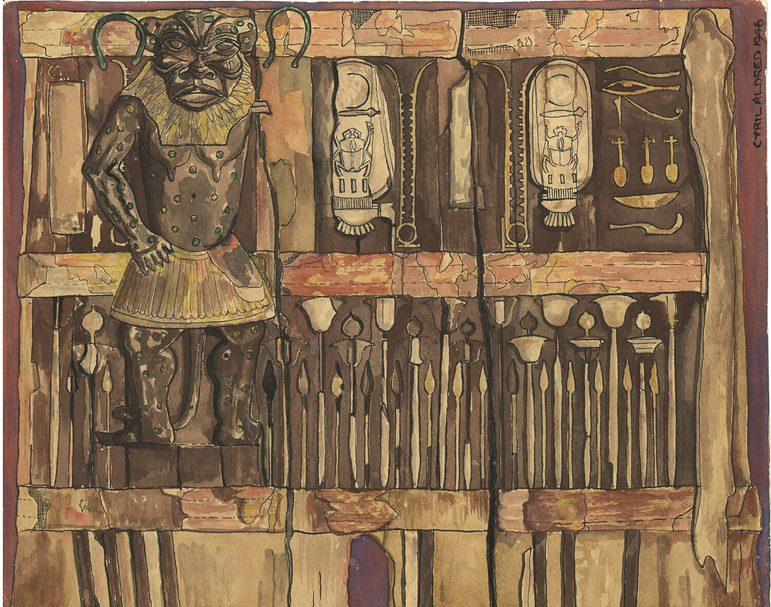
Drawing of the box of Amenhotep II by Cyril Aldred, 1946.
The royal names on the box are surrounded by further symbols. The cartouches sit on top of the Egyptian hieroglyph for ‘gold’, which was associated with divinity and eternity. On either side of each cartouche are notched palm ribs. The ribs of palm tree branches were used as a method of recording time. After being stripped of their leaves, palm ribs were notched to serve as a tally for counting days. A palm rib acted as the hieroglyph for ‘year’ and as a symbol of a long reign. On the box, the palm ribs are depicted on top of circular shen rings, another ancient Egyptian symbol of eternity.
Papyrus plants are depicted on the lower half of the box. The papyrus plant and the colour green symbolised life, growth, rebirth, good health, and success.
Together all of the decoration on the box served to ensure a long and successful reign for King Amenhotep II.
How did the box arrive in Edinburgh?
The origin of the Amenhotep II box is something of a mystery. It is thought to have been brought back from Egypt by Alexander Henry Rhind (1833–1863). Rhind was a young Scottish archaeologist who used groundbreaking archaeological methods in Egypt in the 1850s.

Portrait of Alexander Henry Rhind of Sibster, oil on canvas, by Alexander S. Mackay, 1874. Museum reference H.OD 7.
National Museums Scotland holds several hundred objects collected by Rhind. This includes a burial assemblage from an intact Roman Egyptian tomb, which he discovered in Thebes (modern Luxor). The start to his remarkable career was cut short when he died at the age of just 29. The legacy he left to the Society of Antiquaries of Scotland continues in their annual Rhind lectures.
Despite Rhind’s high standards of recording for the era, the exact origin of the box is not clear. It was reportedly found broken in several pieces in a box of Rhind’s miscellaneous finds by the director of the National Museum of Antiquities, Joseph Anderson (1832–1916), in the late 19th century.
The eminent Egyptologist Sir Flinders Petrie wrote an article about the box in 1895:
...in a recent visit to Edinburgh, Dr Anderson was good enough to show me a portion of a casket which he had rescued in fragments from a box of miscellanea belonging to the Rhind Collection, and had carefully reunited.

The Amenhotep II box as photographed in 1895, after its initial reconstruction.
A later museum curator, Egyptologist Cyril Aldred (1914–1991), proposed that the box must have been excavated by Rhind in the same tomb in which he had made another remarkable discovery: the remains of the burials of ten princesses, daughters of Thutmose IV (around 1400–1390 BC) and of Amenhotep III (around 1390-1352 BC), the son and grandson of Amenhotep II.

Inscribed wooden labels from the burial of daughters of Thutmose IV and Amenhotep III. Museum reference A.1956.163, A.1956.159, and A.1956.164.
The tomb in Sheikh ‘Abd el-Qurna on the west bank of Thebes (modern Luxor) had been robbed in antiquity and little remained apart from a series of wooden labels inscribed with their names. It was proposed to be a reburial, and the labels were assumed to have been attached to the princesses’ bodies when they were moved. However, recent discoveries in and around the Valley of the Kings have demonstrated that labels like these were commonly attached to royal burial items. Furthermore, Rhind’s notes confirm that the seals on the tomb were those of King Amenhotep III, indicating that it was the princesses’ original burial place.
The box's exact origin remains a mystery, but the Rhind Tomb of the Princesses remains the best guess for its provenance.
Piecing the box together
The box of Amenhotep II survived in a fragmentary state. Before sieving became a common technique in excavations, it was not unusual for small items to be missed. Nowadays, as archaeologists revisit sites, a surprising number of ‘lost’ fragments belonging to objects excavated 100 years ago or more are being discovered.
A recently discovered fragment decorated with papyrus plants matched the design on the box exactly, but it connected directly to another fragment that looked significantly different. So why didn’t it match? Historic photos and drawings of the box by Cyril Aldred, a former curator at the Museum and an expert on ancient Egyptian art, revealed the answer. The band of decoration around the lower edge of the box had originally been severely damaged and subsequently restored in the 1950s – unfortunately incorrectly.
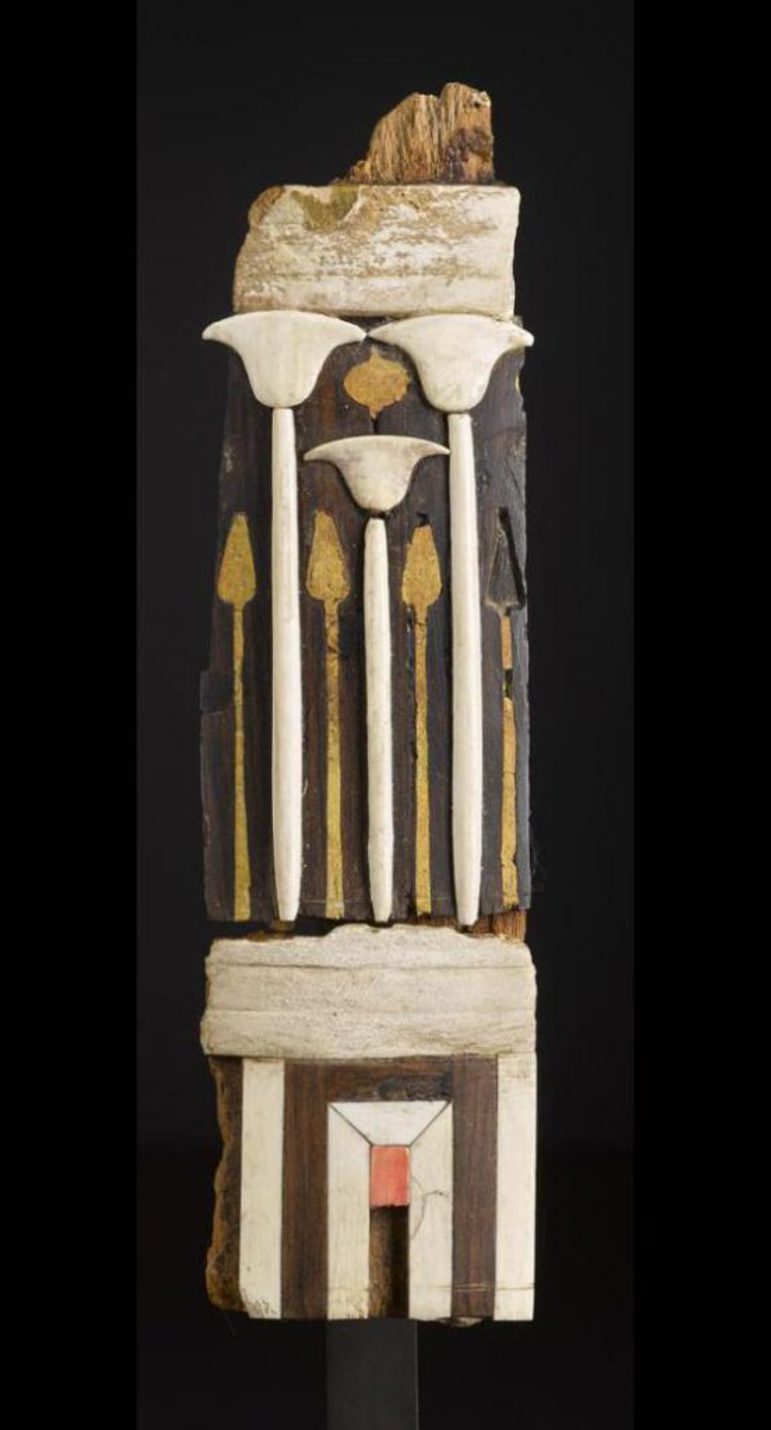
Two rediscovered fragments from the box of Amenhotep II. Museum reference V.2016.43.
The only surviving elements on the box were a few vertical stripes of ebony and ivory. It is understandable that the restorer interpreted that this must have been an alternating pattern of vertical stripes, however, this kind of design is not represented anywhere else in Egyptian art. The closest comparable use is motif of vertical stripes flanking a central rectangular arch that evokes the façade of the royal palace. The design dates back to the very beginnings of Egyptian history, though it continued for millennia afterwards. It is thought to represent the mudbrick and reed exterior of a royal palace; as such, it was closely bound with the concept of kingship.
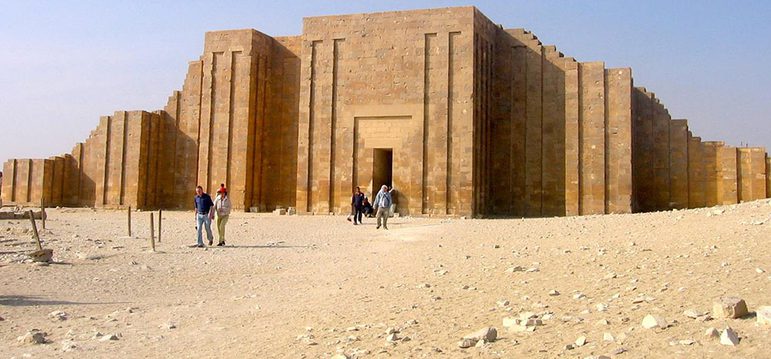
Palace-façade design on the enclosure wall of King Djoser’s Step Pyramid complex, Saqqara, Egypt (c.2650 BC).
The palace-façade design on the rediscovered fragment revealed important information about the original design and rich symbolism of the Amenhotep II box, and a further clue about its origin. The fragments further strengthen the theory that the Amenhotep II box came from the tomb of his granddaughters and great-granddaughters, handed down as an hierloom, and used by the princesses in their daily life in the actual palace. Few palace objects survive from Egypt, so this royal box offers a rare insight into that exclusive world.
The fragments enhance our understanding of this extraordinary artwork. The complex yet harmonious design, the richness of the materials, and the exquisite carving makes it an object of significant artistic importance.
To learn more about this artwork, watch this short film with Margaret Maitland, Principal Curator, Ancient Mediterranean, and Charles Stable, Artefact Conservator.
The box of Amenhotep II (museum reference A.1956.113) is on display in the Ancient Egypt Rediscovered gallery on Level 5 at the National Museum of Scotland.
